 Things are looking great to take on the PCT next year. I managed to secure a start date in early May (numbers are limited to 30 starting each day) and I now have my US visa approved in my passport. Now to apply for leave from work and get planning. There are quite a few logistical challenges to consider for this hike and early preparation is the key. And of course there is the physical prep to do as well. Looking forward to the challenge. I thought about modifying this blog to record my PCT journey but have had second thoughts. I’ll leave this blog as it, mainly dedicated to TeAraroa, and blog my PCT trip on my primary site mickbeckers.com Be sure to subscribe to keep updated and follow me through the US from Mexico to Canada.
Things are looking great to take on the PCT next year. I managed to secure a start date in early May (numbers are limited to 30 starting each day) and I now have my US visa approved in my passport. Now to apply for leave from work and get planning. There are quite a few logistical challenges to consider for this hike and early preparation is the key. And of course there is the physical prep to do as well. Looking forward to the challenge. I thought about modifying this blog to record my PCT journey but have had second thoughts. I’ll leave this blog as it, mainly dedicated to TeAraroa, and blog my PCT trip on my primary site mickbeckers.com Be sure to subscribe to keep updated and follow me through the US from Mexico to Canada.
The next adventure
I might have to do a bit of rearranging of this blog. Initially set up to capture my journey along Te Araroa, I have used it to capture a trip to Mt Cook and I’m keen to continue using it to record my next adventure – the Paciffic Crest Trail next year. This site gets a lit of traffic for other people planning to walk Te Araroa and it’s great to see my words being read. It would be a shame to ditch it all and loose that resource for others to use. So if you can bare with me, I might juggle a few things around over the next couple of months to keep the content but rearrange it by adventure name. What do you think? I might need a new blog name as well given I’m now well into planning project 42. Any ideas? I’d love to hear them.
Aoraki – Mt Dixon Video
Version 2.0 of my trip to Aoraki. While I didn’t reach the summit of the Mt Cook, we did go climbing and got a 3,004m summit in.
Aoraki Day 4: Undeterred
Not to be put off from yesterday’s attempt our attention quickly turned towards Mt Dixon on the northern end of the Grand Plateau. At 3,004 metres Mt Dixon is an easier grade climb than Aoraki but just as committing, particularly returning in the soft snow.

We had a later start today but still up early and out the door by 4am to make use of the harder snow to reach the start of the climb in the light of day. As we exited the door small slow furries appeared so we donned shell layers but the weather quickly cleared and it would be another blue sky day.
Travel across the glacier was fast and we were soon warmed up. With the sun now rising it good quite warm already and we stopped briefly to strip off outer layers.
Reaching the bergschrund below the south east ridge we traded walking poles for ice axes and commenced our ascent, Ervin on lead and me belaying from below.
Getting across the schrund was easy enough but it did required crossing over the deep gap on a narrow snow bridge that looked like it had collapsed a little in yesterday’s intense sun. Once across the ground quickly rose from flattish, say 20 degrees, to about 40 degrees. We were aiming for a steep and narrow couloir that would lead up several hundreds metres up to access the top of the south east ridge, leading towards the summit.
Finding some fixed anchors below the couloir we clipped in and were ready for the first serious pitch. The couloir was in deep shade and very icy. Quickly rising close to 60 degrees it required using both ice tools and front pointing on crampons to ascend. A short vertical section of ice was encountered on the way up but nothing too serious. My main ice axe is a standard straight shaft tool for glacier travel that works ok on steep ice but is not purpose built like many of the modern bent shaft ice tools, so working my way up the ice my thinly gloved hand kept smashing into the ice as I drove the tool in. My second tool has a bent shaft and wasn’t so bad on the hand.
I climbed on, seconding Ervin and cleaning protection out of the wall that he had placed on lead. On reaching each belay I would tie in, kick in a small foot platform, and belay Ervin up the next pitch. Being so narrow the couloir we were in would funnel loose snow, ice and rock debris down from above as Ervin climbed on. I hate the ‘whoomp’ sound as debris screams past your head from up high. If you’re not looking up it hard t see it come barreling towards you and react by moving out the way and staying close to the side walls. But by looking up you’re also asking for this debris to able to hit you in the face and not your helmet. A couple of times I looked up to cop a flurry of snowy crystals in the eyes.
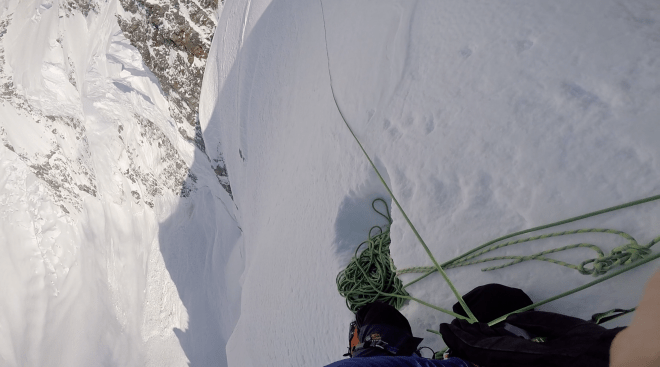

I forget how many pitches were required to the top of the ridge, 4 maybe 5. Protection was mixed the whole way up, some ice screws, a bit of rock protection and snow stakes higher up in the softer snow.
On reaching the ridge line the sun was fully awake revealing the whole ridge line to the summit and 360 degrees right around.
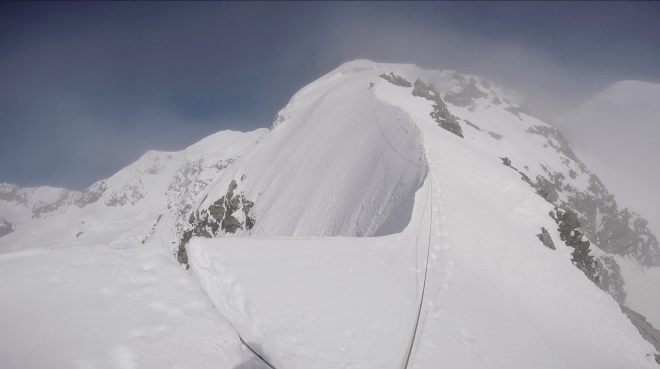
We would continue pitching our way up towards the summit along the knife blade ridge. While we were protected with secure anchors I still had no desire to take a slide or for Ervin to take a slide on lead. We had the rope run out to it’s full 60m length on multiple occasions and any major slip would see the faller penduluming for 60m, plus the stretch in the rope. Falling on the south side of the ridge would have meant swingly steeply across steep snow/ice fields and if you’re unlucky, potential to reach cravasses below. On the northern slope the terrain was steeper with the added danger of narrow rock chutes below. Best not to fall.
And so we continued along the ridge towards the summit, often pitching and belaying, other times short roping and walking simultaneously to save some time, encountering all kinds of conditions up high, a mix of hard ice, hard snow and sugar crystal like dry snow.
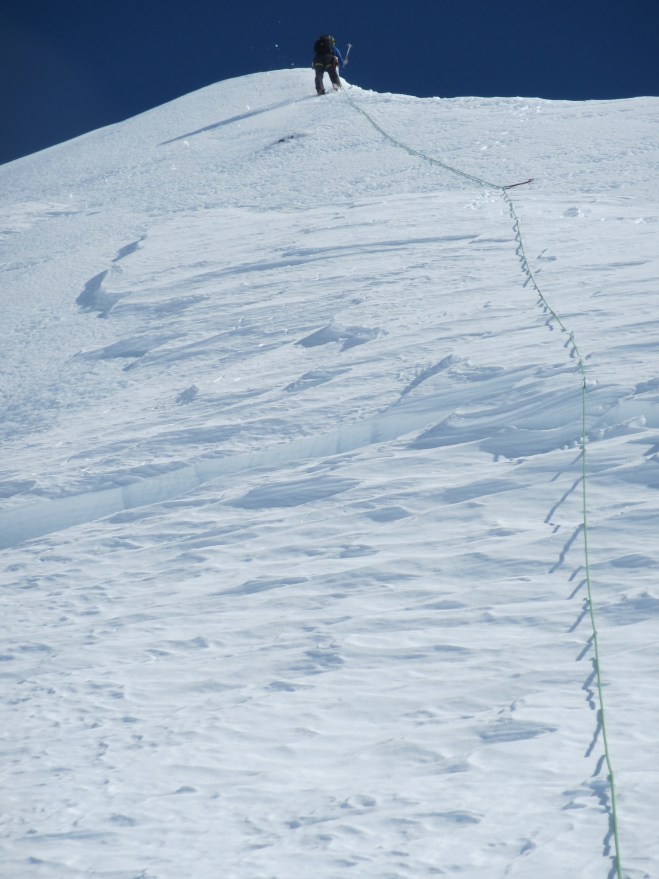

With a loud holler we reached the summit at 1 pm in softening conditions, Aoraki and Mt Tasman standing proud in the back ground.
Stopping briefing briefly to refuel, rehydrate and snap the obligatory summit photos we didn’t linger. At only half way, it was going to be a long day.
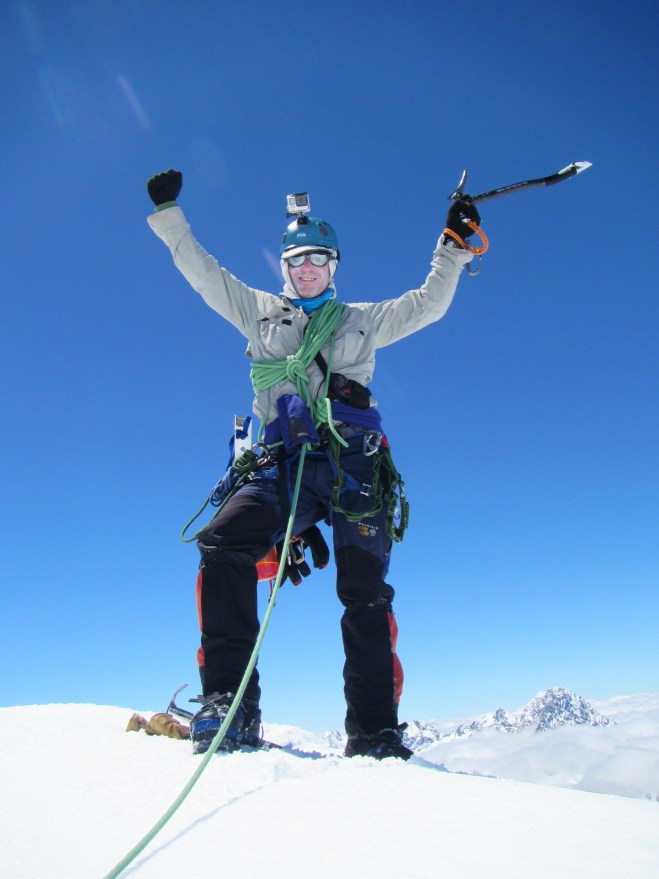
The snow had significantly softened by early afternoon and necessitated further pitching to ensure we remained safe. Slow going for sure. Heading down I tried lots of techniques, facing forward and walking on easier ground with soft snow, facing into the slope to front point down on steeper terrain and plugging steps and ice tools to traverse a few sections. Traversing the steepest section of the ridge was exhilarating. Looking down between my feet there was nothing but air for 700m straight down to the base of the ridge. You know it’s precarious when you’re told “No mistakes here!”.

The avalanche danger was constantly with us on the descent with the top layer of fresh snow from previously days not yet fusing to the hard stuff underneath and softening in the heat of the day. At one point I took a steep and heard that sickening deep crunch of snow about to give way underfoot. Without panic there was nothing to do but move quickly further down, ice axe in hand to arrest any potential fall. But all was good. Phew!
Reaching the the top of the couloir again it was now just a matter of rappelling down to the glacier using double ropes to get the full 60 m length of rope for 4 pitches. Rappelling down we had to leave a deadman anchor on the ridgetop, abandoning a snow stake to be eaten by the mountain over time. Further down we made use of fixed anchors where they could be found in the snow and relied on building an anchor using slings around secure rocks.
Safely back down it was long hard slog back across the glacier to the hut. This was probably the worst part of the whole day. The snow was very, very soft and would swallow your feet with just about every step, often upto the knees and occasionally up to your thigh. Hard work indeed.
We would reach the hut at around 8pm after a 14 hour day but I was on a massive high.
Aoraki Day 3: Alpine start
At 12am I got a tap on the foot, the signal to get up, get ready and get going. A typical alpine start, leaving so early makes best use of the harder snow/ice conditions frozen overnight, making travel a bit faster and given how long a climbing day we expected would allow for a descent at a reasonable hour in the afternoon to avoid (as best as possible) the potential for afternoon avalanche conditions.
A standard climbing day on Aoraki is around 15-20 hours long.
As you move through the upper Linda Glacier you reach one of the main danger points on the mountain, The Gun Barrels, several very steep and narrow couloirs (gullies) that collect heavy snow and ice very high above. The couloirs are position in a way that and avalanche debris are aimed straight down onto the route. A particularly nasty section to negotiate in the afternoon with sun softened material.
Our intended route would see us through the Linda Glacier, Upper Linda Glacier, under the Gun Barrels, onto the Linda Shelf, on the summit rocks and then onto the summit ice cap to the top. We wouldn’t get that far this day.
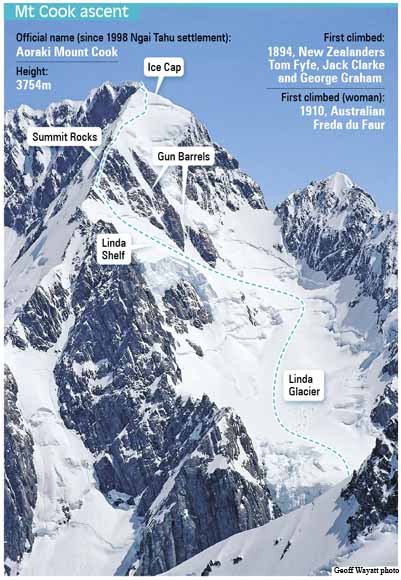
We were roped up and were out the door by 1am, the last of four 2 person teams attempting to climb Aoraki today.
Hitting the glacier in the dark of early morning, I wasn’t feeling at 100% with a stomach ache keeping me awake for a good part of the night – not the best start to a climbing attempt. I didn’t have the shits just an annoying ache and I wasn’t going to let it stop me in my tracks just yet.
The narrow beam of light from my head torch on helmet illuminated the path ahead. Not much to see really and it was a matter of following the rope and Ervin’s headtorch infront, paying attention to maintain a taut rope and not release too much slack into the system. Tiny dots of the head torches of the other climbers could be seen further along the glacier. They were a fair way in front having left earlier than us.
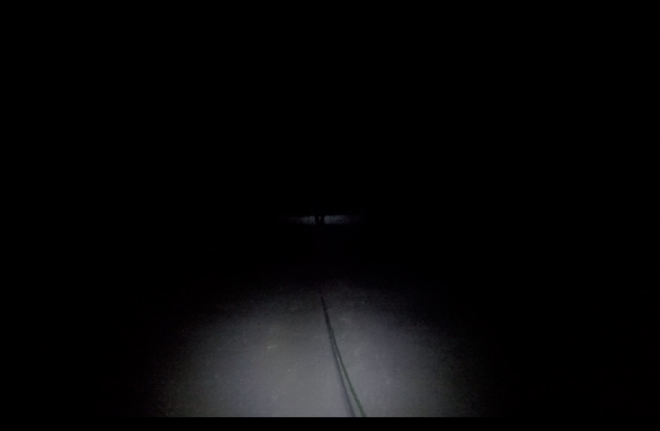
Not much to see in torch light
For four hours we would continue to push through the dark, following our path from yesterday and on reaching our ‘high point’ continue to pick up the new route pioneered by those in front. This was easily followed in soft snow but more difficult on the frozen ground that where crampon marks are not left so readily.
The ground quickly rose up steeply as the path picked its way through large crevasses. At one point we were on very steep ground and hit the edge of a major crevasse, its dark inky interior disappearing below, escaping the meagre penetration of light from my head torch. Obviously the wrong way, we retreated a little, down climbing and finding a path around the edge on to a narrow snow bridge to cross.
As we continued, I wasn’t feeling that great. My energy levels were low and I was rapidly fatiguing, my belly ache not going anywhere. Now I knew that this climb was going to be a big day indeed and was certainly used to hard work, particularly with some of the massive efforts put on Te Araroa earlier in the year. I was no stranger to hard work but my level of fatigue was not just normal tiredness from a bit of extra grunt. As we continued on the upper Linda Glacier towards the gun barrels I was feeling particularly weak.
Looking ahead I could see the beams of light from other teams in front as they moved underneath the Gun Barrels onto the Linda Shelf beginning their traverse across to the Summit Rocks. They were moving really slowly and we were a long way back, with our pace slowing. I reasoned that if the other teams were moving slow and with our slow progress, if we were to continue we were going to be very late in getting back below the Gun Barrels in the afternoon, during the peak avalanche danger period. While I had the energy to continue moving up very slowly towards the summit I didn’t think I was going to have enough in the tank to give the 100% level of concentration required to negotiate back down safely in another 10 hours. I did not want to be a burden and safety concern for Ervin. The snow and ice above the Gun Barrels looked particularly nasty and there were signs of previous slab avalanches on the terrain ahead.
And so it was with a heavy heart that I made the very difficult call to turn around near the Gun Barrels. I was shattered.
But deep down I knew it to be the right decision. Aoraki is not going anywhere and while my dream of climbing this particular peak would not be realised at this point in time, there would be other opportunities in the future. Better to be safe than sorry and make this difficult ascent when I’m at 100%.
Devastated, we hung around for a little bit as the sun was just starting to rise and spread it’s soft light onto the tops of the surrounding peaks. Dark orange touched the higher peaks, transitioning to pink and yellow pastels as the sun rose. It’s that magical time of day when all is peaceful and serene.
Decision made, we turned around to retrace our steps back towards Plateau Hut.
As it turned out it was a major day for all the teams who did continue to climb to the summit. While they would all make it up and back safely, it would be a mammoth 18 to 20 hour day for all – very slow for strong climbing teams and cementing in my head I made the right decision to turn back when we did. In my estimate it would have been a 20-22 hour day for us had we continued.

Early morning sun light

Other teams below the Gun Barrels
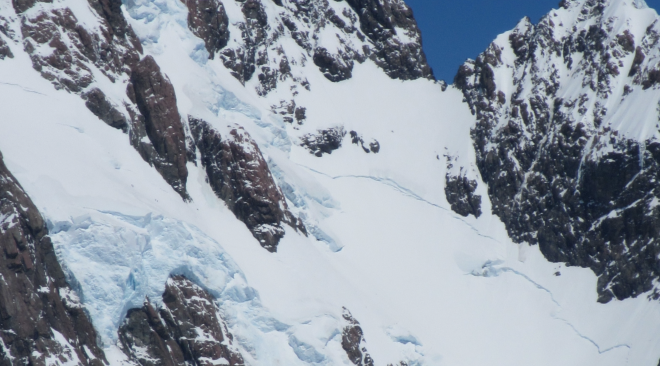
Better view of Linda Shelf and Gun Barrels the following day from Mt Dixon – note climber on the shelf
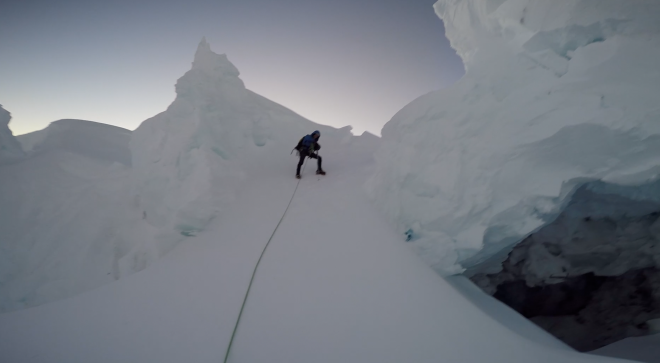
Negotiating back down through the Linda Glacier
Aoraki Day 2: Picture perfect day
On waking this morning the weather had completely changed. Blue skies and clear views surround the hills with next to no wind. Wasting no time we got packed up and headed to the airport to catch a heli into Plateau Hut. Chopper rides are not cheap and were fortunate enough to split the ride with another ground of climbers headed into the hills.
Geared weighted and packed on board we were off the ground in no time, flying up the Tasman Glacier, rising high towards the Grand Plateau and Plateau Hut. The views were incredible. The Tasman Glacier is wide and the ever increasing lake at the head of the moraine a bright blue-green colour, contrasted with the white-grey icebergs blown and collecting at the the southern end of the lake. Lots of fresh snow covering the big mountains.

Moving towards the Grand Plateau we were offered clear views of Aoraki and the Linda Glacier. Seeing our objective up close and from height really pressed home what an awesome mountain it is. The broad sweep of the Plateau extending beneath the high peaks of Mt Cook, Mt Tasman, Lendenfeld, Hasst and Dixon; huge seracs of ice clinging precariously to the sides and long tails of debris scattered in wide arcs at the base indicating recent avalanches.
After a smooth landing on the snow outside the hut we scrambled to do a hot unload of gear with rotors whirring away overhead. Securing loose objects and crouching down over gear as the heli rose, speeding off again to take the other passengers to their destination, snow kicked up in the rotor wash as the machine took off but then… silence. Such an amazing change. With heli gone, I was struck how peaceful the scene was. Not a breath of wind and silence, just silence in the mountains.
Our main mission for the day was to quickly get settled before roping up and hitting the Linda Glacier to reconnaissance a route through. No one had been through the glacier since a fresh dump of more than a metre of snow last week and conditions were unknown. Was the route going to be a tough slog through the fresh stuff? Had the snow partially covered crevasses? How hard or soft were conditions? These questioned all to be answered.
Wasting no time, we were roped up for glacier travel, crampons fixed to boots and ice axe in hand. We headed out to have a look and see who far we would get.
The avalanche forecast was at the highest level it can be with last weeks fresh dump unsettled and sitting on top of a harder lower of snow, causing real potential or slab avalanches to occur.
I forgot just how hot glaciers can be. While the temperature was down, the sheer amount of solar radiation off all surfaces around quickly counteracted this. Layers were quickly shed and more sunscreen applied as we moved through the glacier.
Working our way through the glacier the ground started to kicked up, rising sharply in a few sections, the hard work of slowly plugging steps beginning. While the sun baked snow was a little soft it wasn’t as deep as we thought it could have been after a metre of the fresh stuff. Many areas had been wind blown with the recent snows blown off the surface. Still it was slow work and another day or two of sun would be ideal to help consolidate the surface snow and help it settle onto the base.
The occasional roar of avalanches and loose ice falling away nearby filled the silence that was otherwise occupied with the jangle of climbing gear bouncing around on harnesses and heavy breathing.
Picking our way through large crevasses, partially filled in with snow and with snow bridges in tact we pushed up towards the foot of the Bowie Ridge before calling it a day. The terrain from there kicked up quite steep and it didn’t make a lot of sense to continue in the soft stuff. Further progress would be easier in the dark with the overnight freeze. We retraced our steps to the hut for some rest and food. We would return in the early morning to see if we could push to the top.
Aoraki Day 1: Into the hills
I rolled into Aspiring Guides this morning to meet my guide and go through gear before hitting the road to drive towards Mt Cook Village. I’ll be climbing with Ervin from Slovakia who has a very strong guiding background all over the world. He is here in New Zealand for this climbing season, his 2nd season in NZ. I’m in good hands.
The weather was a bit ordinary today, with strong winds and patchy rain over Aoraki. Too windy to fly into Plateau Hut today so we opted to go climbing on some local crags. That’s all good. With lots of fresh snow last week the avalanche danger due to slab snow forming was raised to high so a bit of rain today will help pack the fresh stuff down. Plus the forecast is looking brilliant for the next 3 days, warmish (for the hills) and sunny. So on top of the todays rain, the sun will help melt the snow more and consolidate it more.
There hasn’t been anyone up to Plateau Hut since the snow which means lucky us we’ll have to cut new trail through the Linda Glacier, picking through cravasses and finding a route through. We’ll spend the next two sunny days doing this, pushing as far up as we can each day and climbing low to rest with a summit run planned for early Friday morning around 1am. But we won’t be alone. With the forecast fining up (perfect timing I must say) at least 2 more teams of two are headed up tomorrow and Aspiring Guides have another team flying in Thursday. Many hands (or legs should that be) make light work, particularly when it comes to cutting new trail in fresh snow.
The climbing today was awesome fun. Grade 12 or 14 I think. Easy climbing on exposed terrain and very well protected on fixed bolts the whole way. 6 pitches on a 60 metre rope we got in before the winds picked, making for cold conditions and difficult communication at time, yelling over the wind required.
Anyway, tomorrow is looking superb and we have a heli booked for 9 am to fly into Plateau Hut.
Unfortunately, this will the only update you guys get until we are back down on Saturday – no wifi from this point in.
Staying in Unwin Lodge tonight, one of the many facilities owned and run by NZ Alpine Club for NZAC members, of which I am one obviously. Full house here tonight with a large group of 20 or so plus many smaller groups. And how good is having wifi in the hills. I’ll make the most of it for sure.
Watch this space – check back in Saturday.

Aoraki – It begins
It’s a cool day in Queenstown. 11 degrees. Quite a bit different to last Monday’s 37 at home. There is more than a dusting of snow covering the Remarkables, offering a glimpse of what lies in wait in the higher peaks of the main range. The plane was on time and I cleared customs with no worries. It helps to have any thing to declare in the one carry on bag and ready to access. Mountaineering boots, climbing shoes and gaiters were all they were interested in which is good because I didn’t want to have to unpack everything, find that all is good and pack it up again. Anything thats been in contact with soil they want to have a look at. All good. I don’t have a tent for this trip an no climbing rope which they quiz me about.
The shuttle was waiting and it was straight on to Wanaka for me. 98km and about 1 hour by road, in early March this year it took my three and a half days to walk the reverse direction from Wanaka to Queenstown.
Very, very excited to be back on NZ soil and more so for a climbing trip on a big mountain. I can’t wait to get going. Organisation day tomorrow in Wanaka and into the mountains in Tuesday.
Aoraki
While Te Araroa doesn’t quite finish at the southern most point of New Zealand, I’ll take it. And by accepting that I can say I’ve walked from the tip of the North Island to the bottom of the South Island. So almost a year on since I kicked off from Cape Reinga what is left to do? Hmm… let me think about that….
…how does the climbing to the highest point in New Zealand sound? Sounds bloody good to me!
So at the end of November this year I’ll be heading back to New Zealand to climb the ‘cloud piercer’ and since I’ve still got this blog running I thought why not continue to use it to capture my latest adventure in New Zealand. (I really have fallen in love with this country – bring on the day I can move here.)
At 3,724 metres (12,218 feet) Aoraki (Mt Cook) is no mean feat. It has all of the technicality of big mountain climbing seen in places like the Himalayas but without the altitude and acclimatisation issues. Nether the less it will prove a challenge.
With a high level of glaciation, large crevasses to cross and exposure to rock/ice fall and avalanches below the ‘gun barrels’ the climbing difficulty is not to be underestimated.
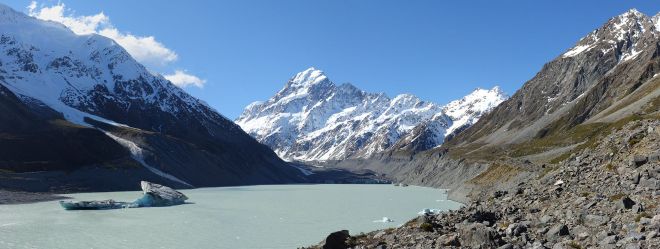
Mt Cook above the Hooker Glacier
I’ve climbed big peaks before, including ascents of Imja Tse (6,189m or 20,300 ft) and Lobuche East (6,145m or 20,100ft) in Nepal and Mt Aspiring (3,033m or 9,950ft) in New Zealand, with Aoraki always being on the bucket list and at the back of my mind. Somehow I have just never got around to it. Seeing it rise majestically above lake Pukaki to form an amazing snow covered back drop as I passed along Te Araroa earlier in the year only seemed to cement the idea of an ascent.
With a number of years rock climbing and mountaineering I’m confident I have the prerequisite skill base for an ascent but just to be on the safe side I will be taking a guide – to keep me on route and that little bit safer. Quizzing Aspiring Guides on whether I have what it takes, they agreed I did and worked with me to secure dates in their quickly filling summer calendar.
So what this space… November is fast approaching and I can’t wait.
To tempt blog follows… here are some photos and bits of pieces of earlier climbs.
Chick here for a 3D look of the route

Mt Aspiring

Summit ice cap on Mt Aspiring

Lobuche East

Lobuche high camp

Lobuche East

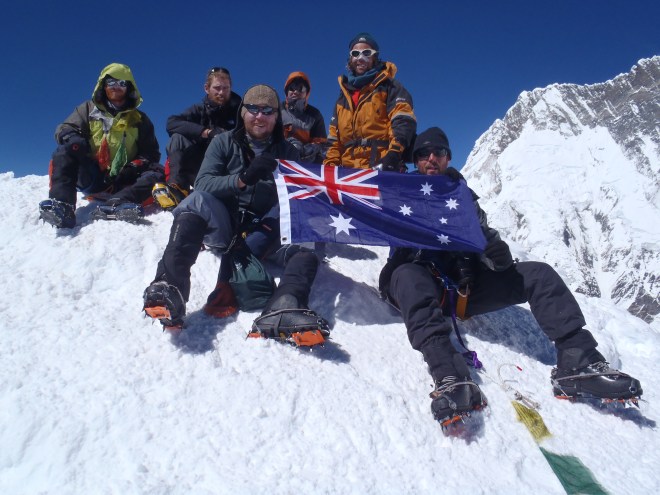
Summit of Imja Tse 6,200m (20,300ft)
Te Araroa – The documentary
Well 4 months after finishing Te Araroa and a lot of video editing later, I now have a documentary that is in reasonable form that I’m happy to share with everyone still following this blog. This is my amateurish attempt at a documentary of the trail. I captured footage along the way mainly as a lasting memory for myself but wanted to get it into some form of movie that I could share with others. Here it is. Most of the footage was captured on my GoPro, held in my hand or supported on my walking pole so it’s a little shaking in spots. Ideally I would have loved to have done more with my cameras but I wasn’t prepared to bring along my Canon 7D SLR -weighing in a over 2 kgs. I also had big ideas of doing lots more pre-placing of the GoPro up the trail but I found constantly having to walk back to retrieve it difficult with so many big and long walking days. I would have loved to have captured more of the people I walk with as well to share to social aspects of the Te Araroa tramping community, but unfortunately didn’t. The final product isn’t too bad IMAO. It’s also my first attempt at using a Mac and Final Cur Pro. Hope you enjoy it.









